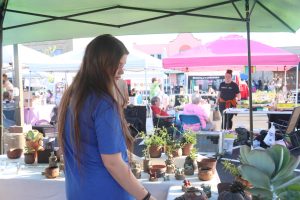AP Psychology students complete swim cap extra credit project
For the project, students draw parts of the brain on a swim cap and present it to a teacher while wearing it
November 10, 2022
In AP Psychology, students are given the opportunity to earn extra credit during one of the more monotonous units: biopsychology. This extra opportunity requires students to draw and label parts of the brain on a swim cap, wear the cap for five minutes in a class and present on five parts of the brain they used while wearing it.
Psychology teacher Kirsten Crandall offers this extra credit opportunity to help students during a unit that is typically more challenging and tedious.
“The brain cap project is designed to give students, number one, the opportunity to earn some extra credit at a time in the year and during a unit in the year that is often times challenging,” Crandall said. “It also provides the opportunity to take a unit where it’s a lot of basic memorization and try to make it a little bit more colorful and a little bit more fun.”
Additionally, this project also helps students remember the content and relate it to their own lives, helping them remember the terms.
“[The brain cap project] forces students to take the content that they have to know, be creative with it and take it outside of the classroom,” Crandall said.
According to senior Maya Parks, this project seemed like a fun way to earn extra credit points.
“I decided to do the extra credit because I saw how easy and fun the assignment was and I thought it would be a good way to earn points for the class,” Parks said.
The process of completing the swim cap project is straightforward. Crandall makes it simple to start the project by allowing students to buy the caps directly from her for $3.
“When Ms. Crandall introduced the project, she allowed us to buy a white swim cap from her,” Parks said. “I colored all the different parts of the brain to emphasize where each location was. The drawing was not very hard because I could make the areas as big as I wanted.”
After drawing and labeling the parts of the brain, the student is then required to get a teacher’s permission to present their swim cap during class. English teacher Peter Shull approved a swim cap presentation in one of his classes.
“I allowed her to present [her swim cap] in my class because it seemed like a good assignment and she was very enthusiastic about it,” Shull said. “The class really enjoyed the presentation because she put her swim cap on a friend and gave a fulsome presentation of all of the parts of the brain that we had already used within just five minutes of class. I thought it was impressive.”
According to Crandall, a large number of her AP Psychology students partake in the extra credit opportunity.
“The number of students that choose to do it is different every year, but I would say on average about a fourth of my students take advantage of it,” Crandall said.
For Parks, the swim cap project was not only a fun way to earn some extra credit, but also something she would do again.
“If there are more extra credit opportunities, I will definitely take advantage of them,” Parks said. “Extra credit is a good way to receive extra points, especially for projects that are easy to do.”









